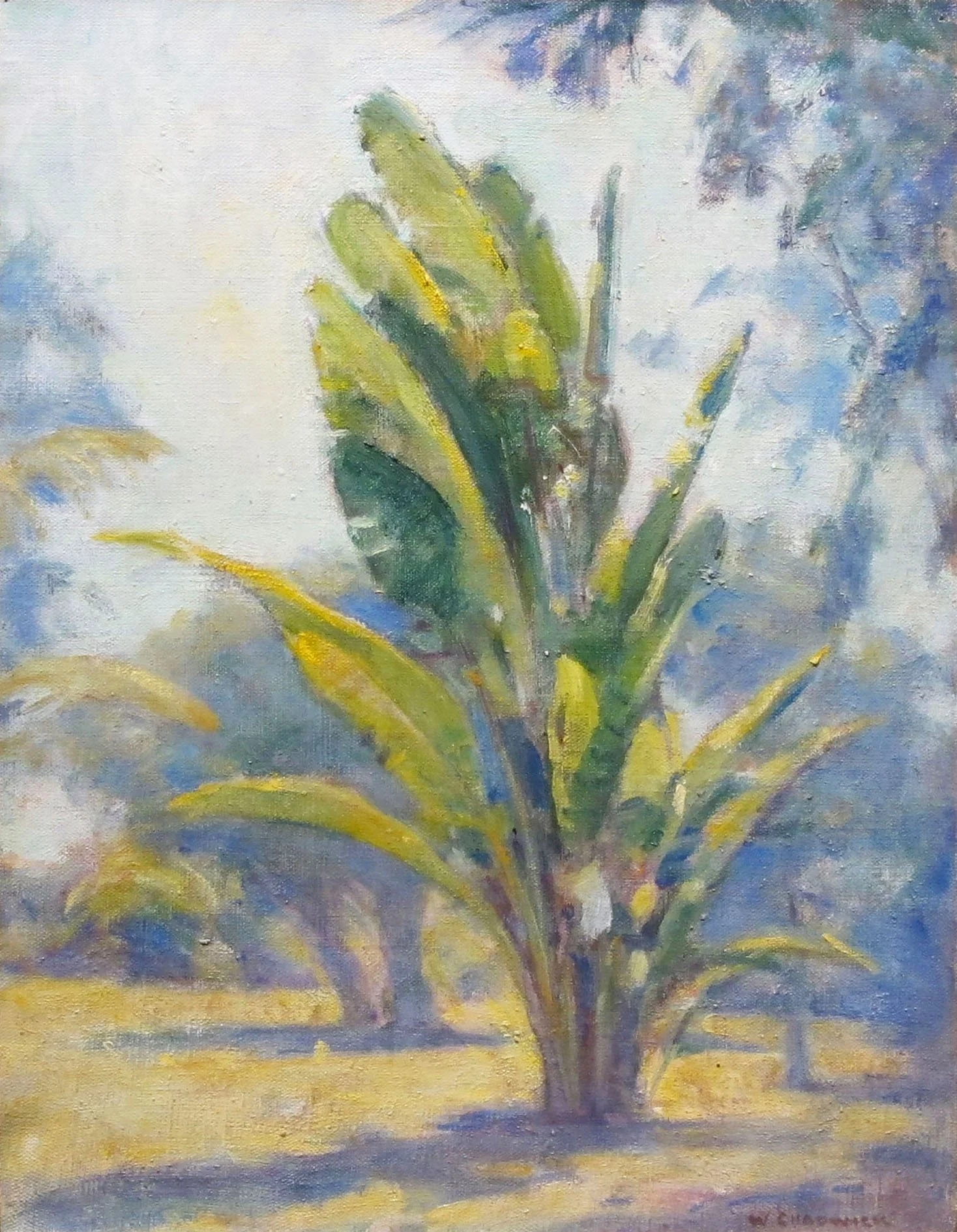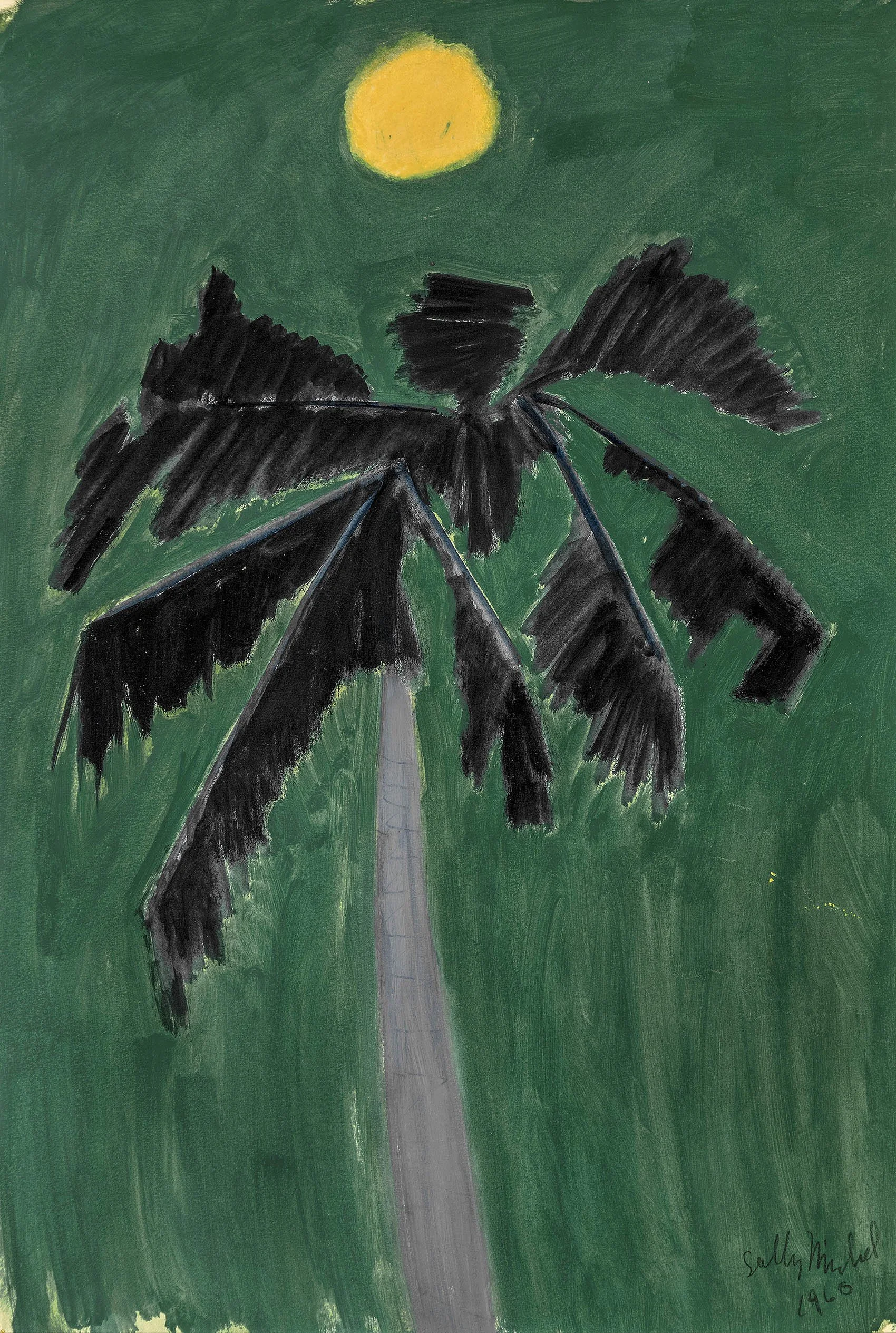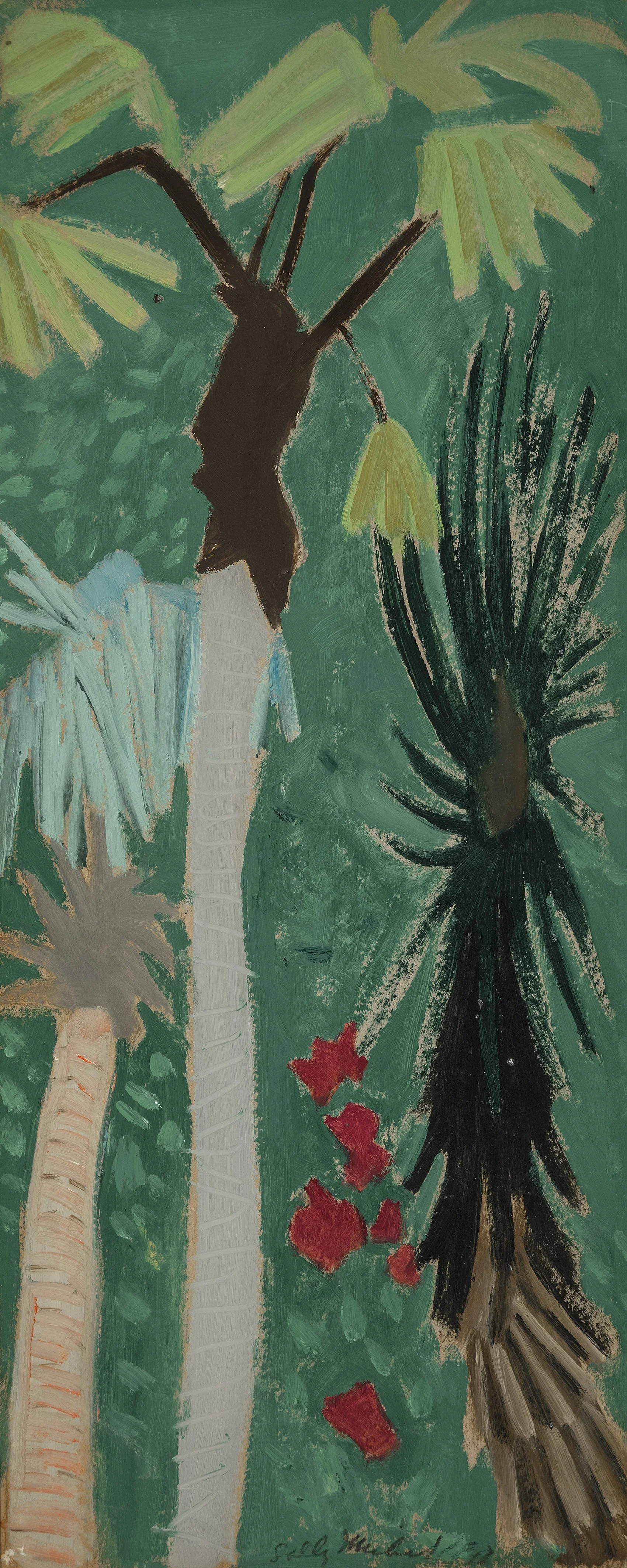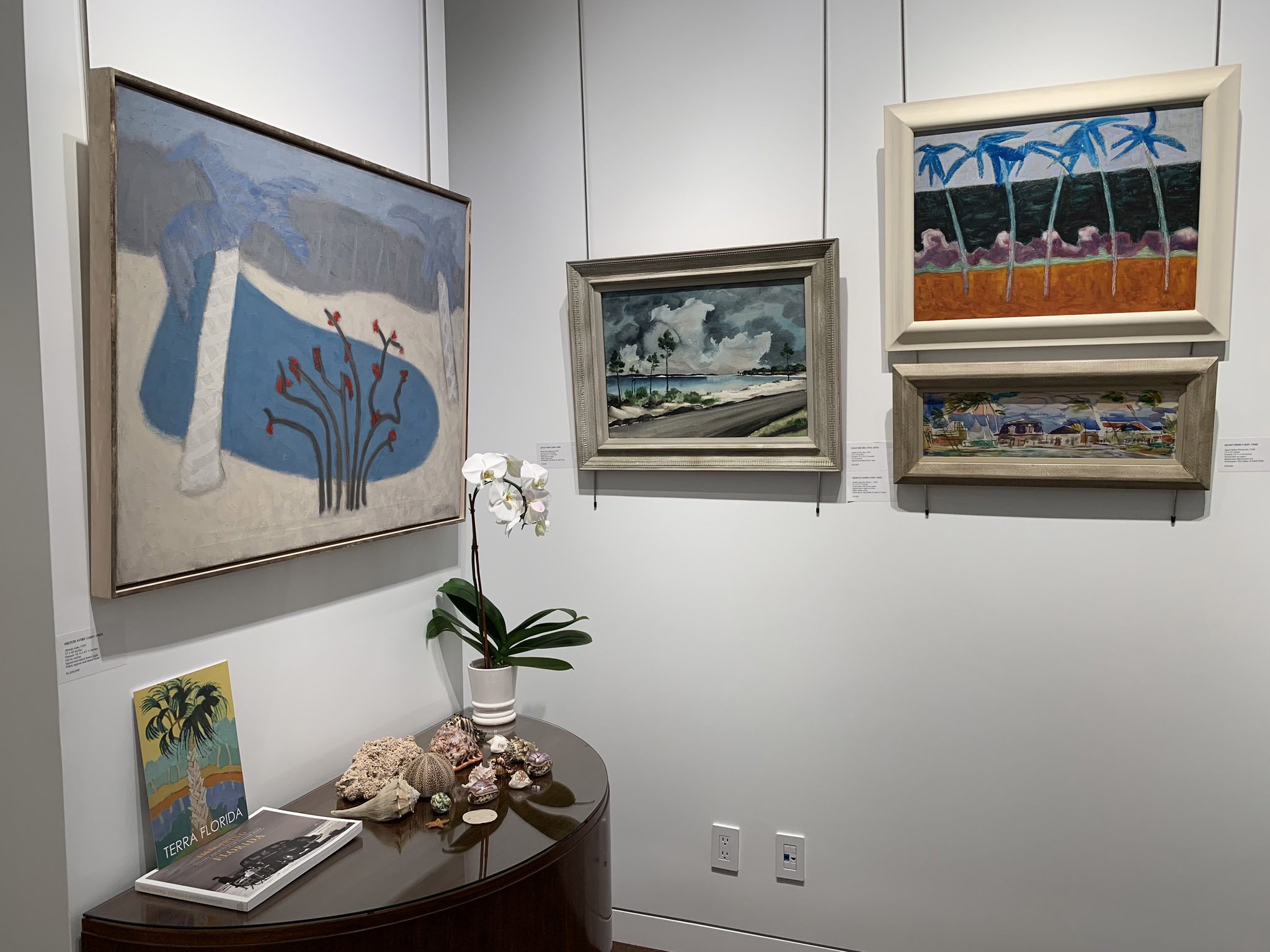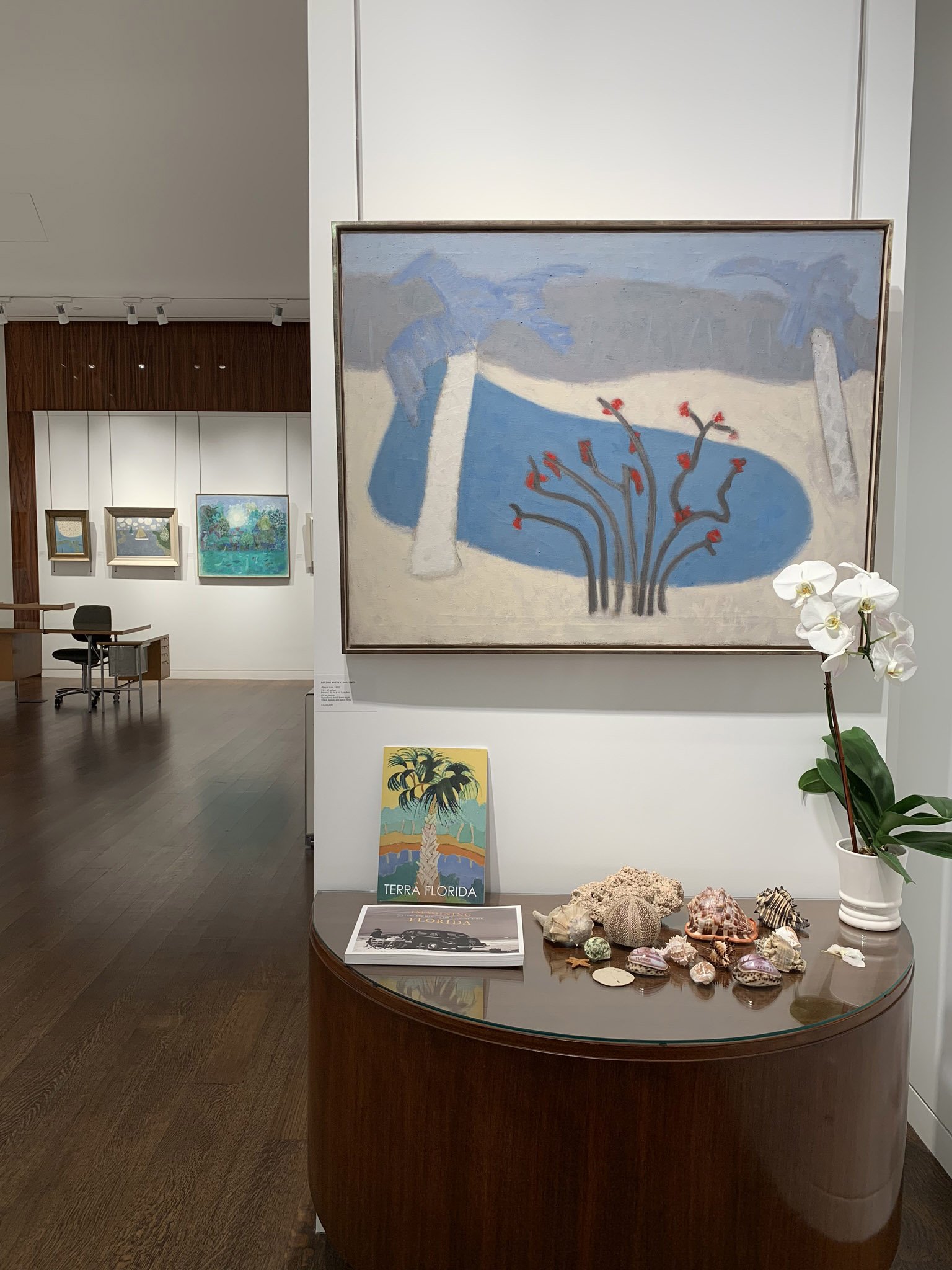Nov 26, 2018 - Feb 22, 2019
Read essay here | Some works may still be available, please contact the gallery at 212-581-1657
Installation Views
Essay by Deedee Wigmore
D. Wigmore Fine Art presents images of Florida by seventeen artists who visited the state between 1920 and 1970. The exhibition grew out of the gallery’s effort to assist Jennifer Hardin in her exhibition Imagining Florida: History and Myth in the Sunshine State (Nov. 13, 2018 through Mar. 24, 2019, Boca Raton Museum of Art). In searching for art created by established artists who visited the state, I was fascinated by the history of the places the artists painted. St. Augustine, Ormond Beach, Palm Beach, Miami, Key West, Naples, Sarasota, Bradenton, Clearwater, and Orlando all are represented in paintings in D. Wigmore Fine Art’s Terra Florida exhibition.
After the acquisition of Florida from Spain in 1821, the state’s cultural progress was held in check by Seminole Indian Wars ending in 1858 and the Civil War. After the Civil War, agricultural cultivation of cotton, citrus, celery, and even mulberry trees for the silk industry, as well as some real estate development and tourism, all opened the way for artists to find Florida a place of interest. However, real advancement of Florida’s culture and artistic growth can be credited to the businessmen who developed railroads, steamship service, and hotels. These builders of Florida were Henry Morrison Flagler, George Merrick, Addison Mizner, and John Ringling. The infrastructure they built established essential services and later with the technological developments made during World War II, tropical living became comfortable.
One of the first areas of Florida where artists worked was on the Northeast coast between the Matanzas and San Sebastian Rivers and along the shore in St. Augustine. There Henry Flagler built the luxurious Hotel Ponce de Leon in 1887 and the smaller Hotel Alcazar in 1888. As a diversion for hotel guests seven art studios were built on the grounds of the Hotel Ponce de Leon and artists invited to be in them. In the 1920s Florida had a real estate boom with significant population growth. In St. Augustine it led to the development of art organizations, which proved to be such an attraction the chamber of commerce started a campaign in 1934 to attract artists from famous northern art colonies. The campaign attracted two hundred artists to St. Augustine by 1939. Some of those artists are represented in our exhibition, including: Jane Peterson (1876-1965), Anthony Thieme (1888-1954), William Chadwick (1879-1965), and Lucy L’Engle (1889-1954). Both Jane Peterson and Anthony Thieme were attracted by St. Augustine’s colonial architecture. In America’s Oldest Wooden Schoolhouse, Jane Peterson painted the wood building at 14th and George Street that first appeared on the tax rolls in 1716. It was made of bald cypress and red cedar held together by wooden pins and iron spikes. Peterson lightened her palette to suit the sun-bleached old structure. Anthony Thieme’s painting Sunny Day shows the Canova-Prince Murat House, located at 250 St. George Street, built around 1815. Thieme’s painting gives the viewer an image of a sleepy town with dappled shadows and subtle gradations of light that filter through the tree-lined streets. William Chadwick painted the blazing light shining on Florida’s unique vegetation in Traveler’s Palm during a visit to the St. Augustine area in 1924-26. Lucy L'Engle was interested in St. Augustine’s Spanish history as a Catholic fort town, as seen in Two Nuns, 1944 and Castillo de San Marco, 1940. L'Engle brought a new style of representational art to St. Augustine as one of the modernist members of the Provincetown art colony.
Ormond Beach was another tourist destination established by Henry Flagler when he purchased The Ormond Hotel in 1890, expanding it to 600 rooms as part of his East Coast Railway. Nearby Daytona Beach was another attraction with auto races held on the beach as early as 1902. Reginald Marsh (1898-1954) made regular trips to Ormond Beach, after his father, artist Dana Marsh, retired there in 1928. The younger Marsh wintered in Ormond Beach in 1930 and 1931, returning to the area for his honeymoon in 1934 and again in 1939. Because of its modern architecture, Dana Marsh called his house The Battleship. In the painting Carousel Horses, 1939, Marsh achieved a Surreal effect as white carousel horses gallop towards the streamlined house under Florida’s bright sun. Yet the scene is in fact the view of The Battleship from the beach. Dana and Reginald Marsh found carousel horses at a local dump and rescued them. Painted white, the carousel horses were placed on The Battleship’s lawn.
Palm Beach developed in the mid-1890s when Henry Flagler extended his railroad to link coastal cities from St. Augustine to Key West with luxurious hotels along the line, some using Addison Mizner’s exotic Mediterranean architecture. Flager built his own palatial home, Whitehall, which he moved into in 1902. Adolf Dehn (1895-1968) was in Palm Beach from 1949-1951 teaching at the Norton Gallery and School of Art. This allowed him the time to create a substantial body of work in Florida. Our Terra Florida exhibition includes a rare large ink and wash painting executed in 1949 by Adolf Dehn to capture one of Florida’s stormy moments when a hurricane hit West Palm Beach.
Another important Florida city is Miami, reached by Flagler’s East Coast Railway in 1896. The great designer and artist Louis Comfort Tiffany (1848-1933) first visited Miami in 1917, building his house Comfort Home there from 1921 to 1923. Tiffany was in Miami to experience the 1924 opening of George Merrick’s Venetian Pool, a rock quarry transformed into a Mediterranean style public swimming pool, in Coral Gables. Tiffany painted the Venetian Pool in a subdued palette and softened light emphasizing the architecture of the pool buildings. The Mediterranean architecture of Venetian Pool was soon replaced by Miami Art Deco. In the 1930s streamlined housing came to Miami aided by the Miami architect Robert Law Weed who created the Florida Tropical Home for the 1933 Century of Progress International Exposition in Chicago. The modernist New York artist Virginia Berresford (1904-1995) began to winter in Miami in 1943 when her Navy husband Lieutenant Commander Benedict Thieland was stationed there. Berresford remained in Miami until 1950. Prior to that, Berresford wintered in Key West from 1934 until her move to Miami. Florida’s intense light and shadow and new flora and fauna inspired Berresford to work in watercolor using daring free strokes and bright colors, loosening the flat hard planes of her earlier geometric style. These works were a success, resulting in solo exhibitions in New York at Montross Gallery in 1934, the Walker Gallery in 1936, and Marie Sterner Gallery in 1938. Berresford joined the war effort by volunteering for the Miami Red Cross to teach watercolor technique to hospitalized soldiers.
Key West, the southernmost city of the continental U.S., was famous for salvage from local ship wrecks, fishing, salt production, and cigar making. The Overseas Railway was constructed to connect the island with the mainland in 1912. However, a hurricane demolished the railroad in 1935 and it was replaced by the Overseas Highway which put Key West in touch with Miami. Adolf Dehn (1895-1968) was often in Key West from 1945-1948. Our exhibition offers Key West Beach Scene, 1948 in which the artist captures some of the eccentric characters seen on the beach. Dehn also visited the Florida Panhandle, spending time in Pensacola in 1938 and 1942 where he did the watercolors we are showing: Beach Near Pensacola and Sand Dunes, Pensacola. Francis Chapin (1899-1965), a Chicago Modernist, first visited Orlando in 1929 when his father retired there. A popular instructor at the Art Institute of Chicago’s School of Art from 1929-1947 and at the Institute’s summer art school in Saugatuck, Michigan from 1934-1938, Chapin was invited twice to be the visiting artist at Stetson University in Deland, Florida near Orlando. He taught there in 1947 and 1964. Chapin found the experience so wonderful he continued to winter in Orlando and Key West. Our exhibition offers five watercolors of Key West subjects, including the marina and the bustle of the town with its shops and traffic.
Kansas-born artist, Henry Varnum Poor (1888-1970) came to Florida the winter of 1929-1930 when he took a break from producing his successful ceramics to shift his focus back to painting. Poor first went to Naples, Florida in the winter of 1929-1930, but finding the town too populated for his taste, Poor choose nearby Marco Island for his winter retreat. At Marco Island, Poor felt in tune with nature and painted the three watercolors offered in our exhibition: Marco Island Fish House, 1930; Docked Yacht, 1935; and House, 1935.
Sarasota is another city that attracted artists. It began as a military fort in 1842, incorporating as a town in 1903 when it was reached by rail service. John Ringling’s arrival in 1912 shifted the town from agriculture (it was known for its celery crop) to a tourist center. By the early 1930s, Sarasota had an air strip, baseball diamonds for the New York Giants and the Boston Red Sox, and a municipal golf course built and dedicated by Bobby Jones. Ringling developed homes, hotels, an art museum, and brought Ringling Brothers and Barnum and Bailey Circus to Sarasota for winter quarters. In 1931 he built a Junior College and School of Art. The artist who oversaw the development of the teaching program at the Ringling School of Art was George Pearse Ennis (1884-1936). In Sarasota, Ennis was interested in the remaining Seminole tribes that lived along the edge of the Everglades. As an artist and designer of art glass, Ennis was taken with Seminole craft traditions, which led him to get to know and paint Seminole people. Our exhibition includes Ennis’s painting A Seminole Maiden in the Everglades, 1932. Another artist in our exhibition, Lucile Blanch (1895-1989) taught at the Ringling School of Art in 1936-1937 where she created the watercolor Ringling Work Horses. Blanch also visited one of the oldest towns along the east coast of Florida to research its history for a mural commission for the Fort Pierce post office. David Burliuk (1852-1967), a central figure in the Russian avant-garde who exhibited with the Blue Rider Group in Munich, came to America in 1922 and started wintering in the Sarasota area in the 1940s. He visited the barrier islands of the North Port-Sarasota area at Anna Maria Island and Longboat Key. He set up his studio each winter in Bradenton, which could be reached from U.S. 41 between Tampa and Sarasota. Burliuk’s painting Beached Boats, 1953 captures the beach, birds, boats, and blue sky that charmed Burliuk.
The Maitland Research Studio was an art colony outside Orlando, formed in 1937 by artist J. André Smith. The center offered unique architecture in its Mayan Revival style. Sally Michel Avery (1902-2003) and her husband, Milton Avery (1885-1965), spent the winters of 1949-1950 and 1950-1951 at the Research Studio where Milton received a Bok Fellowship. They came to Florida because Milton was recovering from a heart attack and his physician recommended Milton spend the winter in a warmer climate. While at the Research Studio, Milton focused on sketching subjects for watercolors and monoprints, which he could later develop into paintings in his studio. One painting by Milton Avery titled Florida Lake is offered in our exhibition. With freedom to paint in Maitland, Sally was charmed by Florida’s palm trees, birds, and bathers. We can see this in the six Florida paintings by Sally Michel in our exhibition.
The artist couple Arnold Blanch (1896-1968) and Doris Lee (1904-1983) traveled extensively throughout Florida. Blanch, a highly respected artist, teacher, lecturer, and visiting art critic was a winter resident of Key West in 1916. He was one of the first artists to visit the area before it became a favorite tourist spot. Blanch shared his love of Florida in 1934 with Doris Lee. Blanch taught at New York’s Art Students League and also the League’s summer program in Woodstock, New York. Each year, after Thanksgiving, the couple would leave Woodstock and drive to Florida. Arnold would teach art across Florida while Doris painted. During the 1930s they traveled to Key West to exhibit in the WPA sponsored art exhibitions, which were a draw for many artists. According to Tennessee Williams’ memoir, Lee and Blanch joined him along with Grant Wood and Yasuo Kuniyoshi in Key West the winter of 1941-1942. Life Magazine commissioned Lee to travel around the Gulf of Mexico by car to create images of the area for an article on the Pan-American Highway in 1946. In addition to Key West, the couple particularly liked the Clearwater area. Lee was a charter member of the Clearwater Art Club formed in 1935. In 1951 both Lee and Blanch received solo exhibitions at the Florida Gulf Coast Art Center. Both artists were Bok Fellows at the Maitland Research Studio in 1949-1950 when Milton and Sally Michel Avery made their first Florida visit. By 1954, Lee and Blanch had purchased winter homes in both Key West and Clearwater. In the mid-1960s, Lee retired to the Clearwater area and Blanch continued to paint there each winter. Our exhibition includes an oil by Arnold Blanch titled Birds and Trees, 1966 as well as a gouache titled Figures by the Sea executed during winters in Florida. We have matched this by offering an oil by Lee titled Sailboats on a blue ocean just off a curvy sandbar shore. An oil by Lee titled Approaching The Beach suggests the viewer is flying over the ocean looking down onto a sand bar patterned by collaged-on beach towels.
I feel I have just scratched the surface of Florida’s rich history in presenting some of the notable artists who visited the Sunshine State between 1920 and 1970. In researching the artists and the areas of Florida that attracted them, I discovered the pioneering spirit that is so American in the development of Florida’s cities.
[ TOP ]
Modernism 1913-1950 | Realism of the 1930s and 1940s | Abstraction of the 1930s and 1940s | Post-War | Selected Biographies













